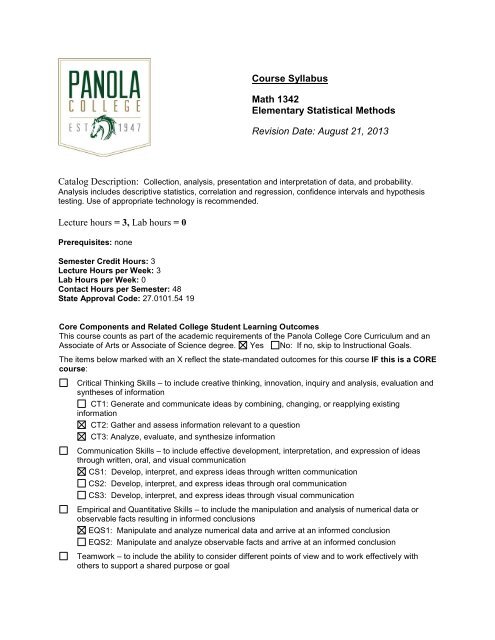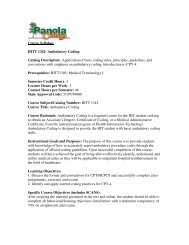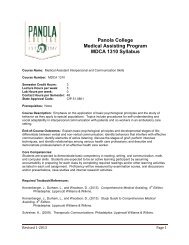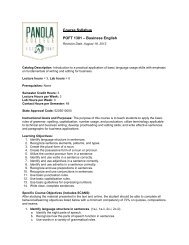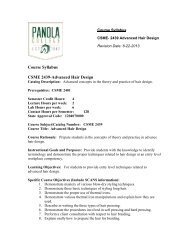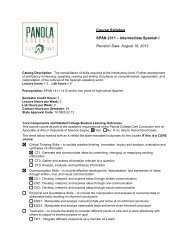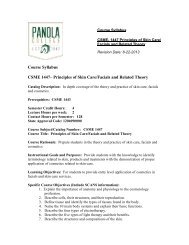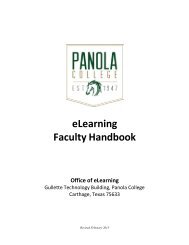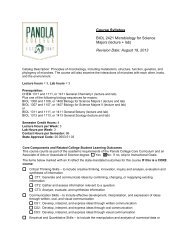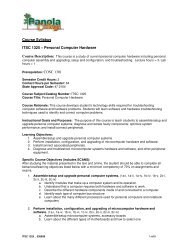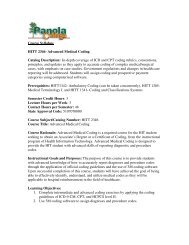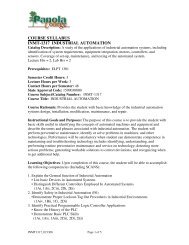Course Syllabus - Panola College
Course Syllabus - Panola College
Course Syllabus - Panola College
Create successful ePaper yourself
Turn your PDF publications into a flip-book with our unique Google optimized e-Paper software.
<strong>Course</strong> <strong>Syllabus</strong><br />
Math 1342<br />
Elementary Statistical Methods<br />
Revision Date: August 21, 2013<br />
Catalog Description: Collection, analysis, presentation and interpretation of data, and probability.<br />
Analysis includes descriptive statistics, correlation and regression, confidence intervals and hypothesis<br />
testing. Use of appropriate technology is recommended.<br />
Lecture hours = 3, Lab hours = 0<br />
Prerequisites: none<br />
Semester Credit Hours: 3<br />
Lecture Hours per Week: 3<br />
Lab Hours per Week: 0<br />
Contact Hours per Semester: 48<br />
State Approval Code: 27.0101.54 19<br />
Core Components and Related <strong>College</strong> Student Learning Outcomes<br />
This course counts as part of the academic requirements of the <strong>Panola</strong> <strong>College</strong> Core Curriculum and an<br />
Associate of Arts or Associate of Science degree. Yes No: If no, skip to Instructional Goals.<br />
The items below marked with an X reflect the state-mandated outcomes for this course IF this is a CORE<br />
course:<br />
Critical Thinking Skills – to include creative thinking, innovation, inquiry and analysis, evaluation and<br />
syntheses of information<br />
CT1: Generate and communicate ideas by combining, changing, or reapplying existing<br />
information<br />
CT2: Gather and assess information relevant to a question<br />
CT3: Analyze, evaluate, and synthesize information<br />
Communication Skills – to include effective development, interpretation, and expression of ideas<br />
through written, oral, and visual communication<br />
CS1: Develop, interpret, and express ideas through written communication<br />
CS2: Develop, interpret, and express ideas through oral communication<br />
CS3: Develop, interpret, and express ideas through visual communication<br />
Empirical and Quantitative Skills – to include the manipulation and analysis of numerical data or<br />
observable facts resulting in informed conclusions<br />
EQS1: Manipulate and analyze numerical data and arrive at an informed conclusion<br />
EQS2: Manipulate and analyze observable facts and arrive at an informed conclusion<br />
Teamwork – to include the ability to consider different points of view and to work effectively with<br />
others to support a shared purpose or goal
TW1: Integrate different viewpoints as a member of a team<br />
TW2: Work with others to support and accomplish a shared goal<br />
Personal Responsibility – to include the ability to connect choices, actions, and consequences to<br />
ethical decision-making<br />
PR1: Evaluate choices and actions and relate consequences to decision-making<br />
Social Responsibility – to include intercultural competence, knowledge of civic responsibility, and the<br />
ability to engage effectively in regional, national, and global communities<br />
SR1: Demonstrate intercultural competence<br />
SR2: Identify civic responsibility<br />
SR3: Engage in regional, national, and global communities<br />
Instructional Goals and Purposes:<br />
The purpose of this course is to develop critical thinking skills, help students learn to analyze and<br />
interpret different charts and graphs that they might encounter in newpapers, magazines, and online<br />
information sites, and help students improve their decision making skills. Since many degree plans call for<br />
“<strong>College</strong> Algebra or higher”, Statistics (Math 1342) will work as the math requirement in many degree<br />
plans.<br />
Learning Outcomes: [from the ACGM catalog]<br />
After studying all materials and resources presented in the course, the student will be able to:<br />
1. Explain the use of data collection and statistics as tools to reach reasonable conclusions.<br />
2. Recognize, examine and interpret the basic principles of describing and presenting data.<br />
3. Compute and interpret empirical and theoretical probabilities using the rules of probabilities and<br />
combinatorics.<br />
4. Explain the role of probability in statistics.<br />
5. Examine, analyze and compare various sampling distributions for both discrete and continuous<br />
random variables.<br />
6. Describe and compute confidence intervals.<br />
7. Solve linear regression and correlation problems.<br />
8. Perform hypothesis testing using statistical methods.<br />
<strong>Course</strong> Content:<br />
Students in all sections of this course will learn the following content:<br />
1. Define and/or explain the concepts of vocabulary, terminology, and notation used in this course.<br />
2. Create a frequency distribution from a set of data, and draw a histogram from this table. Perform<br />
analysis of histograms.<br />
3. Create a pie graph, a pareto chart, a scatter-plot, and a stem and leaf plot from a set of data,<br />
either by hand or using statistical software. Perform analysis of different charts constructed.<br />
4. Compute mean, median, mode, midrange, variance, and standard deviation of data sets.<br />
Compare and contrast the measures of center.<br />
5. Compute the z-score and percentile of a given score of data sets.<br />
6. Compute the probabilities of simple and compound events. Use critical thinking to interpret the<br />
results.<br />
7. Summarize the results of a probability procedure in a probability distribution. Calculate the<br />
mean, variance, and standard deviation of a probability distribution.<br />
8. Find the probabilities associated with binomial distributions. Find the mean, variance, and<br />
standard deviation of a binomial distribution.<br />
9. Find the probabilities associated normal distributions.<br />
10. Construct a confidence interval for mean, proportion, and standard deviation and use critical<br />
thinking to interpret the results. Determine the sample size necessary to estimate the mean,<br />
2
proportion, and variance.<br />
11. Test a hypothesis about a mean, proportion, and standard deviation and use critical thinking to<br />
interpret the results.<br />
12. Find the linear correlation coefficient, perform a hypothesis test for linear correlation, and find<br />
the equation of the regression line of a linearly correlated set of data. Use critical thinking to<br />
interpret the results.<br />
Methods of Instruction/<strong>Course</strong> Format/Delivery: Lecture/demonstration, discussion, problem<br />
solving, and analysis. Homework will be assigned.<br />
Assessment: The assessment of competencies will be by class activites, homework, and examinations.<br />
<strong>Course</strong> Grade: The grade for this course will be based on<br />
Five (5) Major Exams at 11% each 55%<br />
Homework Notebook and Quizzes 15%<br />
Attendance 10%<br />
Final Examination 20%<br />
Texts, Materials, and Supplies:<br />
Textbook: Elementary Statistics using the T83/84 Plus Calculator, 3E,<br />
by Mario F. Triola, Pearson Education, Inc., © 2011.<br />
ISBN 978-0-321-73914-8 (New text is bundled with Statdisk, Students Solution<br />
Manual, and MyStatsLab Student Access Code),<br />
ISBN 978-0-321-64148-9 (Used text purchased through the PC Bookstore is<br />
bundled with Statdisk and the Students Solution Manual; if purchased used<br />
online you can purchase the Students Solution Manual separately (ISBN 978-0-<br />
321-64157-1) ).<br />
Internet Students must purchase MyStatLab Student Access Code (ISBN: 978-<br />
0-321-641731) only and use an online textbook. You can also purchase<br />
MyStatLab at www.pearsonmylab.com . You must you have reliable high speed<br />
internet access.<br />
Calculator:<br />
A TI-83or TI 84(+) is necessary for this course.<br />
Other:<br />
For current texts and materials, use the following link to access bookstore listings:<br />
http://www.panolacollegestore.com<br />
For testing services, use the following link: http://www.panola.edu/elearning/testing.html<br />
If any student in this class has special classroom or testing needs because of a physical learning<br />
or emotional condition, please contact the ADA Student Coordinator in Support Services located<br />
in the Administration Building or go to http://www.panola.edu/student-success/disability-supportservices/<br />
for more information.<br />
Withdrawing from a course is the student’s responsibility. Students who do not attend class and<br />
who do not withdraw will receive the grade earned for the course.<br />
Student Handbook, The Pathfinder: http://www.panola.edu/studentsuccess/documents/pathfinder.pdf<br />
3


